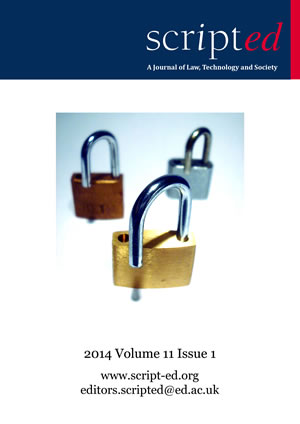(2014) 11:1 SCRIPTed 1–144
Issue DOI: 10.2966/scrip.110114

Cover image
- 3 Padlocks (unlocked)
Nick Benjaminsz
Editorial
- Information Governance as a Force for Good? Lessons to be Learnt from Care.data
Mark Taylor, pp.1-8
| HTML | PDF |
Care.data has been in the news rather a lot recently. What do the trials and tribulations of the programme, and the government’s response, tell us about public and professional confidence in the ability of data protection law to effectively protect privacy in today’s information age? What is more, how well does it illustrate, the capacity for information governance, as well as information technology, to shape society in the months and years ahead?
Reviewed Articles
- Lessons from Technology and Intellectual Property in the Oil and Gas Industry in Scotland: a Scholarly Journey and an Empirical Review
Abbe Brown, pp.9-37
| HTML | PDF |
This article explores the intersection between regulation and community practice in the energy sector in Scotland, from the perspective of providing a base for new approaches to the development of new technologies. Consideration of this is timely, given the possibility of Scotland becoming independent and no longer subject to obligations of the European Union and the World Trade Organisation in respect of intellectual property (IP): Scotland may be able to make new choices in respect of the regulation of innovation. The concurrent presence of particular forms of regulation and sharing in the energy sector suggested an approach which enabled innovation to be encouraged whilst remaining attractive to investors and avoiding the significant power conferred by IP (which has itself led to concerns by scholars and activists). This article analyses a pilot set of empirical interviews testing the intersection between the regulation and sharing, in which it was established that they are quite distinct; one could not argue, then, for the suggested approach on the basis that it drew from the established practice in a successful industry. The regulation and sharing practices provide a solution, however, to a new issue which arose from the interviews – the comparative lack of embracing of new technologies in the oil and gas industry in Scotland. If it is adopted, analysis of this solution would contribute to the scholarly debate regarding private and public control of innovation and technologies. - Identifying ‘the invention’ in Inventorship Disputes
Moshood Agbolade Abdussalam, pp.38-68
| HTML | PDF |
This article focuses specifically on the ascertainment of “invention” in inventorship disputes which arise from joint innovative engagements. Joint inventorship gives rise to several questions including: what the invention consists of; the quantum of collaboration supplied by parties; what significant contributions have been made by the respective parties; and whether there has been joint conception. This paper is concerned only with the definition and identification of “the invention” in patent entitlement disputes. It argues that the sum of inventive concepts disclosed in the specification, rather than the claims, should be the touchstone for determining of what constitutes the invention in such contexts. This article submits that the technical details contained in the specification should be preferred to the claims when one is considering inventorship in such cases because: a) the disclosure contained in the specification predates the claims; b) the claims derive their existence from the specification’s disclosure; c) the specification provides the technical background through which the claims could be understood in circumstances of ambiguity; d) the specification serves as a measure of proportionality between a protection sought and the technical contribution furnished; and e) the specification avoids inequitable assertions of entitlement in inventorship disputes.
Analysis
- Present Thinking About the Future of Intellectual Property: A Literature Review
Jeremy de Beer, Alexandra Mogyoros, and Sean Stidwill, pp.69-117
| HTML | PDF |
This article presents the results of a systematic review and analysis of the way that “the future” is addressed in intellectual property literature. Iterative methodical searches in key databases of published materials and targeted reviews of grey literature revealed a limited number of relevant works pertaining to the future. These works were analysed and classified according to our original taxonomy, considering for example: whether the future was conceived as predictable or uncertain; whether the analysis was issue – specific, IP – categorical, or systemic; and whether the work considered legal, economic, technological, social, environmental, or ethical factors driving change. Quantitative and qualitative analyses of the literature demonstrates very few works that consider multiple factors driving systemic changes in an uncertain future. The article describes and recommends the use of distinct research tools, specifically foresight and scenarios methods, capable of addressing this gap in our present thinking about the future of intellectual property.
Case Commentary
- The Data Retention Directive Never Existed
Judith Rauhofer and Daithí Mac Síthigh, pp.118-127
| HTML | PDF |
Analysis of the decision of the Court of Justice of the European Union in Joined Cases C-293/12 (Digital Rights Ireland) and C-594/12 (Kärntner Landesregierung), on the validity of the Data Retention Directive.
Reports
- Launching a Report on Unlawful File Sharing
Piers Fleming, Daniel John Zizzo and Steven James Watson, pp.128-131
| HTML | PDF | - Graphic and Novel: an Arts and Law Project
Shawn H. E. Harmon, pp.132-136
| HTML | PDF | - “Innovation in the Law”: the Second Annual Edinburgh Postgraduate Law Conference
Leslie Stevens, pp.137-139
| HTML | PDF |
Book Reviews